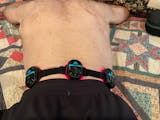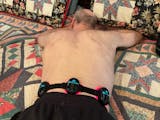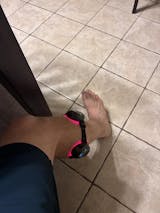Fluid on the knee, also known as knee effusion, can be a sign of an underlying issue like injury, infection, or inflammation. While it’s not always dangerous, it can lead to more serious problems if not addressed. In this article, we’ll dive into what causes fluid on the knee, whether it’s dangerous, and how you can treat and prevent it, including using
medical-grade red light therapy devices.
What is Knee Fluid
Understanding Knee Effusion
Knee effusion refers to the accumulation of excess fluid in the knee joint. This fluid is usually synovial fluid, which normally lubricates the joint. When the knee becomes injured or inflamed, the body produces more fluid to protect the joint, which can lead to swelling and discomfort.
Symptoms of Fluid on the Knee
If you have fluid on your knee, you may notice swelling around the joint. It might feel tight, and bending or straightening the knee could be difficult. Pain is often associated with the swelling, especially when putting weight on the leg. These symptoms can range from mild to severe.
How Knee Fluid Affects Mobility
Excess fluid can limit the range of motion in your knee. Simple movements like walking, standing, or going up stairs might become painful. This limitation can impact daily activities and may cause long-term discomfort if the fluid isn’t addressed properly.
Causes of Fluid Buildup in the Knee
Injury or Trauma
Knee fluid can often result from an injury, such as a sprain, strain, or ligament tear. When the knee is hurt, the body sends fluid to the area as part of the healing process, which can lead to swelling. In these cases, the fluid buildup may subside as the injury heals.
Infections and Inflammation
Infections in the knee, such as septic arthritis, can lead to fluid buildup. Inflammation caused by autoimmune diseases, like rheumatoid arthritis, also triggers the production of excess fluid. If the knee becomes infected, it’s essential to seek medical attention immediately to avoid more serious complications.
Osteoarthritis and Degenerative Conditions
For those with osteoarthritis or other degenerative joint conditions, the cartilage in the knee wears down over time. As the joint becomes inflamed, the body produces more fluid, which can lead to swelling and stiffness, especially after periods of rest or inactivity.
Other Medical Conditions
Certain conditions, like gout or bursitis, can cause fluid to build up in the knee. Gout, for example, occurs when uric acid crystals accumulate in the joint, leading to inflammation and fluid accumulation. If you have an ongoing medical issue, it’s important to get an accurate diagnosis.
Is Fluid on the Knee Dangerous
Short-Term vs. Long-Term Risks
In the short term, fluid on the knee might just cause discomfort and swelling, but in the long run, untreated fluid buildup can result in joint damage. If the underlying cause is not addressed, you may experience chronic pain or permanent changes to the knee’s structure, affecting its function.
Risk of Infection and Further Complications
If the fluid buildup is caused by an infection, it can spread to other parts of the body, leading to sepsis, a life-threatening condition. This makes early diagnosis and treatment critical. Additionally, untreated inflammation can damage the cartilage, leading to long-term knee problems.
Impact on Joint Health
Fluid buildup in the knee can cause the joint to become stiff and weak. Over time, this can lead to permanent changes in the knee’s range of motion and function. Chronic inflammation from conditions like osteoarthritis can also accelerate joint deterioration.
How to Treat Fluid on the Knee
Home Remedies and Self-Care
If the fluid buildup is mild, you can try the R.I.C.E method—rest, ice, compression, and elevation. Applying ice to the knee for 15-20 minutes every few hours can help reduce swelling. Over-the-counter pain relievers may also provide temporary relief.
Medical Treatments for Knee Effusion
For more severe cases, your doctor might need to drain the fluid using a needle, a procedure called aspiration. This can provide immediate relief from swelling. In some cases, corticosteroid injections may be used to reduce inflammation.
The Role of Medical-Grade Red Light Therapy Devices
Red light therapy devices can be a non-invasive and effective way to reduce inflammation and accelerate healing. By stimulating cellular repair, these devices can help reduce pain and swelling, making them a valuable tool for those recovering from knee injuries or fluid buildup.
When to Seek Medical Attention for Knee Fluid
Signs of Severe Infection or Inflammation
If you notice redness, warmth, or increased pain around the knee, these could be signs of infection or severe inflammation. Seek medical attention immediately if you have a fever or if the swelling worsens, as these symptoms may indicate a serious condition.
Persistent Swelling or Pain
If swelling or pain persists for more than a few days, it’s time to see a doctor. Long-lasting fluid buildup can indicate that the knee joint is not healing properly, or that an underlying condition needs to be addressed.
Limited Range of Motion
A decrease in your knee’s range of motion could mean that the joint has been damaged. If you’re unable to fully bend or straighten your knee, consult with a healthcare provider to determine the cause and get the right treatment.
Preventing Fluid Buildup in the Knee
Proper Exercise and Stretching
Keeping the muscles around the knee strong can help prevent fluid buildup. Strengthening exercises for the quadriceps, hamstrings, and calves can support the joint and reduce the risk of injury. Stretching before and after physical activity is also key to maintaining knee flexibility.
Weight Management
Maintaining a healthy weight can reduce the strain on your knee joints. Excess weight puts additional pressure on the knees, which can trigger inflammation and fluid buildup, especially in those with existing conditions like osteoarthritis.
Protective Gear and Safety Measures
If you’re involved in sports or activities that put stress on your knees, wearing knee pads or braces can provide added protection. This can help prevent injuries and reduce the likelihood of fluid buildup from overuse or trauma.
Recovery and Rehabilitation After Fluid Removal
Rest and Rehabilitation Exercises
After draining fluid from the knee, rest is essential. However, physical therapy and rehabilitation exercises can help restore strength and mobility to the knee. Gradual movement and stretching can also reduce the chances of future fluid buildup.
The Importance of Monitoring Knee Health
It’s important to regularly monitor the condition of your knee after fluid removal. Ongoing checkups can help catch any issues early and ensure that the knee is healing properly.
Using Medical-Grade Red Light Therapy Devices for Recovery
Conclusion
Fluid buildup in the knee can be a sign of injury, infection, or other conditions. While not always dangerous, it can lead to long-term complications if left untreated. If you experience swelling, pain, or limited mobility, seek medical attention promptly.
FDA approved red light therapy can help relieve pain and swelling, promoting faster recovery.
Red light panels are suitable for large-area treatments, while
red light masks focus on facial care, addressing multiple facial areas simultaneously. They are particularly suitable for anti-aging, soothing, and repairing, improving skin texture, and alleviating acne problems.




















Share:
What Is the Knee Thing
What Is Runner's Knee